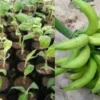- このトピックは空です。
- 投稿者投稿
- 3月 26, 2025 10:30 am #607269

The medicinal properties of plants are often intricately linked to their growth and the chemical compounds they produce. Sida acuta, a widely recognized medicinal plant, is no exception.
Understanding how environmental factors influence the development and phytochemical makeup of its roots is crucial for optimizing its cultivation and harnessing its therapeutic potential. This article explores the significant impact of various environmental conditions on the growth parameters and the concentration of bioactive compounds within the roots of Sida acuta.
1. Influence Of Soil Characteristics
Soil composition plays a fundamental role in plant growth and the synthesis of secondary metabolites. Different soil types, varying in texture, pH, nutrient content, and drainage, can significantly affect the growth of Sida acuta roots. For instance, well-drained soils rich in organic matter might promote robust root development and higher biomass yield.
Conversely, soils lacking essential nutrients or with poor drainage could lead to stunted growth and potentially alter the concentration of specific phytochemicals within the roots. Research investigating the effects of different soil types on Sida acuta root growth and chemical profiles is essential for determining the optimal soil conditions for cultivation.
2. Impact Of Water Availability
Water is another critical environmental factor influencing plant physiology. Both water scarcity and excess can have detrimental effects on plant growth and metabolism. In the context of Sida acuta roots, water stress might lead to reduced root biomass and potentially trigger the accumulation of certain stress-related compounds.
Conversely, waterlogged conditions could hinder root respiration and nutrient uptake, impacting overall growth and potentially altering the production of bioactive molecules. Understanding the optimal water requirements of Sida acuta and how variations in water availability affect its root development and chemical composition is vital for sustainable cultivation practices.
3. Role Of Light Exposure
Light is the primary energy source for photosynthesis and plays a crucial role in plant development and the biosynthesis of secondary metabolites. The intensity and quality of light can influence the growth pattern of Sida acuta roots and the accumulation of specific phytochemicals. For example, plants grown under full sunlight might exhibit different root growth patterns and chemical profiles compared to those grown under shaded conditions.
Research exploring the effects of varying light intensities and photoperiods on the root growth and chemical constituents of Sida acuta can provide valuable insights for optimizing cultivation strategies to enhance the production of desired bioactive compounds.
4. Effect Of Temperature Variations
Temperature is a key environmental factor that influences plant growth rate, metabolic processes, and the production of secondary metabolites. Different temperature regimes can affect the growth and chemical composition of Sida acuta roots.
For instance, extreme temperatures, either high or low, might stress the plant and impact root development and the synthesis of specific phytochemicals. Understanding the optimal temperature range for Sida acuta growth and how temperature fluctuations affect its root biomass and chemical profile is important for establishing suitable cultivation environments.
5. Influence Of Altitude And Geographical Location
Altitude and geographical location encompass a multitude of environmental factors, including temperature, rainfall patterns, soil composition, and light intensity. These factors can collectively influence the growth and chemical makeup of Sida acuta roots.
Plants grown at different altitudes or in different geographical regions might exhibit variations in root morphology and the concentration of bioactive compounds due to adaptation to local environmental conditions.
Investigating the impact of altitude and geographical location on the root characteristics of Sida acuta can provide insights into the plant’s adaptability and the potential for regional variations in its medicinal properties.
Understanding the intricate interplay between environmental factors and the growth and chemical composition of Sida acuta roots is paramount for maximizing its therapeutic potential.
By carefully considering factors such as soil characteristics, water availability, light exposure, temperature variations, and geographical location, it becomes possible to optimize cultivation practices to yield roots with enhanced biomass and a higher concentration of desired bioactive compounds.
Further research in this area will not only contribute to the sustainable utilization of this valuable medicinal plant but also pave the way for developing standardized cultivation protocols to ensure consistent quality and efficacy of Sida acuta root-based remedies.
Read Also: Phytochemical Analysis and Potential Therapeutic Applications of Sida acuta Root Extracts
- 投稿者投稿
- このトピックに返信するにはログインが必要です。






